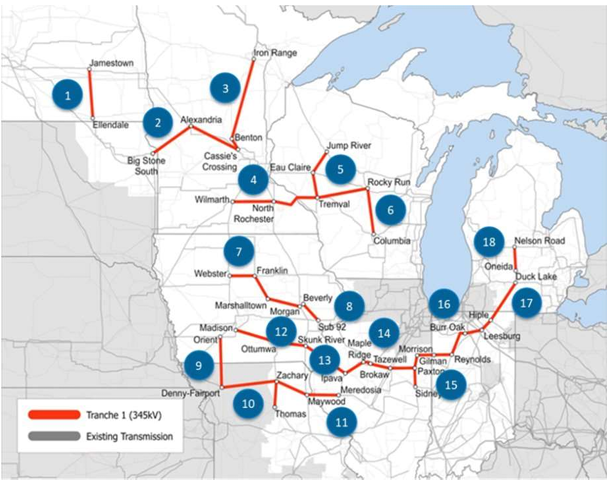
First MISO Tranche 1 Long-Range Transmission Line to Receive Approval
On October 3, 2024, the Minnesota Public Utilities Commission (PUC) approved the Certificate of Need and Route Permit for the eastern segment of the Big Stone-Big Oaks Transmission Line, known as “Line 2” in the Midcontinent Independent System Operators (MISO) Long-Range Transmission Plan (LRTP) Tranche 1 project portfolio. The eastern segment is approximately 108 miles long and will connect the substation in Alexandria, Minnesota to a new proposed substation at Big Oaks near Becker, Minnesota. This is the first line in the 18-line portfolio to receive approval to proceed. The Tranche 1 lines are located in multiple states across the MISO footprint.

The Tranche 1 LRTP portfolio of projects was approved by MISO in July 2022 and will provide $37 billion in benefits over 20 years and improve grid reliability and integration of new renewable energy resources. The Tranche 1 transmission lines are “least-regrets” projects because they are foundational to solving long-standing reliability and efficiency concerns on the regional grid.
This transmission project is designed to strengthen the grid, reduce the likelihood of power outages, and ensure that electricity remains a reliable backbone of our economy, all while enabling the delivery of clean, affordable, renewable energy.
Several advocacy groups, including Audubon Upper Mississippi River, Clean Grid Alliance (CGA), Center for Rural Affairs, Fresh Energy, Minnesota Center for Environmental Advocacy (MCEA), Sierra Club, the Citizens Utility Board of Minnesota (“CUB”), and Union of Concerned Scientists, collectively, the “Joint Commenters,” support this line for its ability to reduce greenhouse gas emissions, enhance system reliability during the clean energy transition, and improve the deliverability of both wind and solar resources from the Dakotas to Minnesota.
“Fresh Energy is very excited to see Minnesota taking the lead on getting MISO’s Tranche 1 portfolio of projects into service,” said Rachel Wiedewitsch, Senior Policy Associate, Clean Electricity at Fresh Energy. “This line is critical to addressing long-standing reliability and congestion concerns out of Eastern North and South Dakota into western and central Minnesota — a corridor especially constrained in the winter during times of peak load and plagued by reliability concerns not only when outages occur, but also when the system is intact. Getting this line in service maintains regional reliability while reducing reliance on fossil fuels by facilitating low-cost renewable energy to Minnesotans from the wind-rich Dakotas.”
“Clean Grid Alliance is pleased that utilities have completed applications for regulatory approval in a timely fashion, and upon receiving them can get the LRTP Tranche 1 lines under construction. We need transmission as soon as possible to alleviate congestion, aid regional reliability, and deliver new, clean resources,” said Beth Soholt, Executive Director, Clean Grid Alliance.
“MCEA is thrilled to see the first of the MISO Tranche 1 lines approved,” said Amelia Vohs, Climate Program Director at MCEA. “This line and others like it are foundational to Minnesota achieving 100% carbon-free electricity by 2040 because they enable the construction of clean energy projects that will replace fossil fuels. This is a win for the climate and a win for the State.”
“Transmission is the backbone of our energy grid, and this key piece of MISO’s Tranche 1 transmission portfolio strengthens this vital infrastructure for Minnesota’s energy future,” said Minnesota Conservative Energy Forum (MnCEF) Executive Director Kayla Christensen. “By expanding our grid capacity and improving connections to home-grown energy sources, this project will help stabilize electricity prices for Minnesota families and businesses, and move us towards greater energy independence and security not just for our state, but for our entire region and nation.”
“This project is an essential part of enhancing the electric grid in rural areas. Updating and improving transmission in rural Minnesota helps reduce congestion and improve reliability, while also providing a new road to market for clean energy,” said Center for Rural Affairs Clean Energy Policy Associate Cora Hoffer. “Wind and solar development create substantial opportunities for rural communities across the state, providing new tax revenue for counties to support essential services and offer a new source of income to farm families.”
